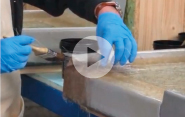Fibreglass Roof Building FAQ'S
Click a question to reveal the answer!
A: Yes it is possible, you need to clean the area thoroughly (preferably using Acetone) then sand back the surface before carrying out your repair.
A: You will need somebody to look at this problem before commenting... If the water has already come through the roof you could have problems that cannot be seen from the outside. Layers of Glass Fibre can be laid into the dip to bring the area to the same level, but you may be covering up a problem. Please call our offices if you would like to discuss the problem in further detail.
A: Care needs to be taken when laminating onto these surfaces, you will need to use a primer on new concrete & asphalt. CYB have primers for these situations.
A: Bitumen will inhibit the cure of GRP. Again, you will need to use a primer coat first.
A: OSB3 Sterling board is the ideal board for GRP roofing (a recommended choice is 18mm, 8 x 2 tongue and groove). GRP will adhere better to OSB3 and if you are using Tongue and Groove there is no need to tape the joints as resin will fall into the gap and adhere the boards together well. As T & G lock together it transfers all expansion to the perimeter edge therefore there is no need to leave expansion gaps between the boards. The 8 x 2 sheets are perfect for roofing as they are easily carried.
A: Yes you can but we recommend that you use a quality grade WBP 18mm you will need to sand the surface before you laminate as bonding to plywood can sometimes be difficult. You will need to consider expansion joints when using anything other than T & G.
A: The pre-formed trims can be nailed to the boards or you can use a Polyurethane sealant such at CT1. Do not use a silicone sealant as silicone will react with GRP.
A: Yes it is possible, you need to clean the area thoroughly (preferably using Acetone) then sand back the surface before carrying out your repair.
A: All RAL or BS colours are available to order. At CYB we have a large stock of all standard roofing colours (Mid Grey, Dark Grey and Black) as well as British Racing Green and White.
A: It is important that you do not use less than 1% catalyst (10ml per kg of Resin) as it will not cure efficiently. Try mixing less quantity of Resin at a time. Resin will cure quicker in the bucket than on the roof as it will exotherm in mass. In very hot weather try to make a temporary shade or work earlier or later in the day to avoid direct sunlight.
A: You can add up to 4% catalyst to the resin (40ml per kg) but do not use anymore as it will have the same effect as not using enough it will not cure! Try leaving the resin in the bucket for a few minutes before using so that it creates heat. If possible, use heaters on the laminated area to speed up the curing process.
A: You will prime your boards during the lamination process (see our roofing guide for details). This process is efficient, by laying the matting onto wet resin before wetting out the first layer you are encourage the resin to be absorbed both underneath and on the top, this results in a good saturation.
A: Flow coat is a Gelcoat, with a wax in styrene additive for use as a Top Coat. Gel coat can be sprayed providing that it is "spray gel coat" not hand lay gel coat. It is not common practice to use a spray system for roofing applications.
A: Redundant GRP based products can go to landfill as long as the resin products are fully cured beforehand. It is important to check with your local landfill site on their regulations.
A: Many architects are recommending the use of Glass Fibre (aka GRP) on roofs of today to eliminate the use of heat applied products. We are happy to help with any planning applications to ensure that the correct materials are used as per the building regs (some areas insist that fire retardant resins are used but others don't). All of our materials are of the highest, Lloyds approved standard. Please do not hesitate to contact our offices to discuss your project.
A: The life expectancy of a GRP roof (if applied properly) is over 25 years. We still have yachts in the water that we built over 30 years ago, you can visit the website http://myweb.tiscali.co.uk/westgatefamily/default.htm The Current Co-Director of CYB LTD (Eric Birch) built every size Jaguar on this site except the Jaguar 27. They have been manufactured by another builder since 1996. Our suggested application of materials for your GRP is based around the manufacture of these boats.


fibreglass supplies for flat roofing and all types of fibreglass projects
connect with us >